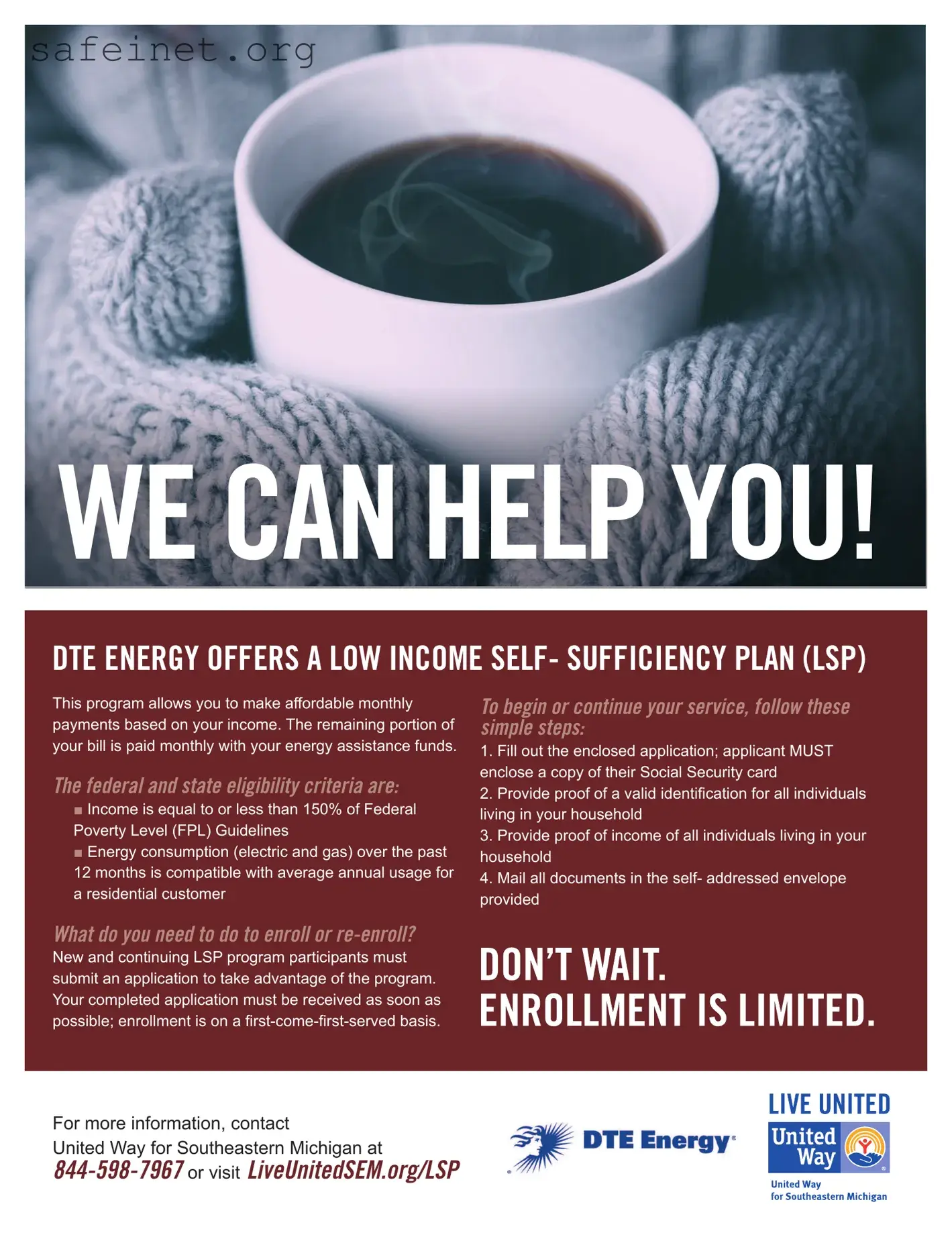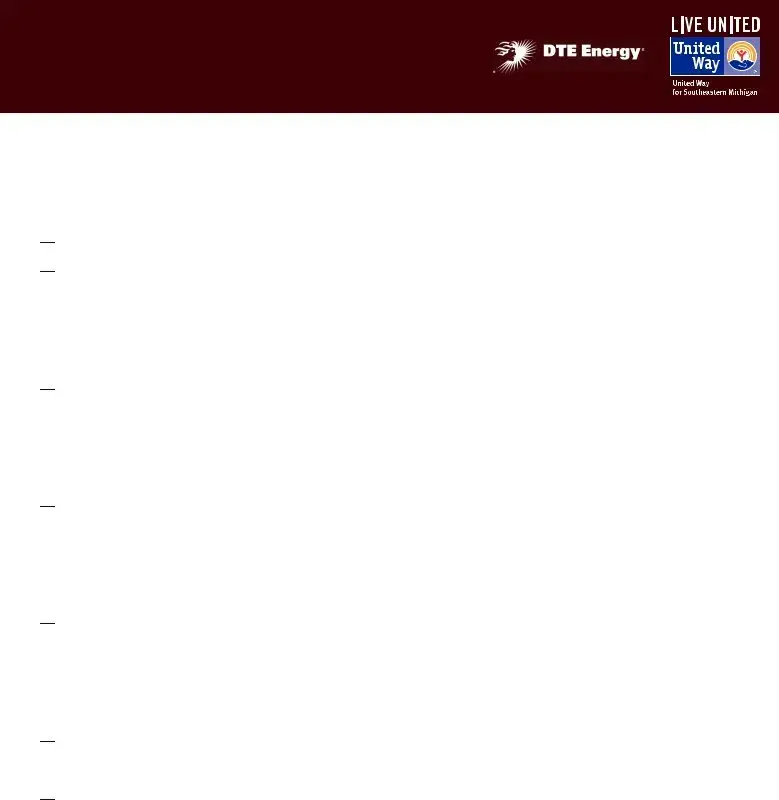WE CAN HELP YOU!
DTE ENERGY OFFERS A LOW INCOME SELF- SUFFICIENCY PLAN (LSP)
This program allows you to make affordable monthly payments based on your income. The remaining portion of your bill is paid monthly with your energy assistance funds.
The federal and state eligibility criteria are:
■Income is equal to or less than 150% of Federal Poverty Level (FPL) Guidelines
■Energy consumption (electric and gas) over the past 12 months is compatible with average annual usage for a residential customer
To begin or continue your service, follow these simple steps:
1. Fill out the enclosed application; applicant MUST enclose a copy of their Social Security card
2.Provide proof of a valid identiication for all individuals living in your household
3.Provide proof of income of all individuals living in your
household
4.Mail all documents in the self- addressed envelope provided
What do you need to do to enroll or re-enroll?
New and continuing LSP program participants must submit an application to take advantage of the program.
Your completed application must be received as soon as possible; enrollment is on a irst-come-irst-served basis.
For more information, contact
United Way for Southeastern Michigan at
844-598-7967 or visit LiveUnitedSEM.org/LSP
LOW INCOME SELF-SUFFICIENCY PLAN (LSP) APPLICATION 2015-16
BEFORE MAILING, CHECK TO BE SURE THAT:
Each section in this application form has been carefully completed ; primary DTE account holder has signed at bottom of page one

 Copy of MOST RECENT DTE bill is enclosed
Copy of MOST RECENT DTE bill is enclosed

 Supporting documents proving identity are enclosed for each household member listed in Section 2 *Driver’s License
Supporting documents proving identity are enclosed for each household member listed in Section 2 *Driver’s License
*State ID
*Birth Certiicate
*Voter’s Registration Card
*School ID
*Health Insurance Card

 Social Security Number Requirement is met:
Social Security Number Requirement is met:
*Social Security Numbers for all members of the household, AND *Social Security Card for applicant, OR
*IRS Tax Transcript displaying full Social Security number, OR *Medicare Card displaying full Social Security number, OR
*Statement from Social Security Administration displaying full Social Security number, OR
*Receipt of Application for Social Security Card from Social Security Administration displaying Social Security number
 Supporting documents are enclosed to prove earned income and expenses are enclosed for all earning members in the household.
Supporting documents are enclosed to prove earned income and expenses are enclosed for all earning members in the household.
Options include:
*Paystubs: All paystubs for the past 30 days. NO PAYSTUBS OLDER THAN 60 DAYS ACCEPTED
*Letter from employer dated within the last 60 days. Letter must include amount of income received per month, must be on company letterhead signed by a supervisor
*Health insurance premium payments, child support payment statements, union dues deductions

 Supporting documents are enclosed to prove unearned/ixed income for the household.
Supporting documents are enclosed to prove unearned/ixed income for the household.
Options include:
*SSI, Social Security, RSDI, SSDI, SDA and/or Pension statement *Child support statement from the court or website *Unemployment award letter dated within the last 60 days *Adoptions subsidy/Direct Care pay stubs
*Proof of alimony or spousal support
 Self-employed household members who earned less than $10,000 last year (before taxes) have signed the Self- Employment Declaration Form; self-employment income of over $10,000 must include federal or state tax forms or Self-employment Proit Loss Statement
Self-employed household members who earned less than $10,000 last year (before taxes) have signed the Self- Employment Declaration Form; self-employment income of over $10,000 must include federal or state tax forms or Self-employment Proit Loss Statement
 If there is ZERO income for all household members, sign and date the No Income Declaration Form. Mail the completed application, along with all necessary supporting documentation within the next 7 days:
If there is ZERO income for all household members, sign and date the No Income Declaration Form. Mail the completed application, along with all necessary supporting documentation within the next 7 days:
Mailbox for UWSEM LSP
535 Griswold Street, Ste. 111-610
Detroit, MI 48226
*Address is used for mail only - no walk-in applications accepted at above address
Have questions or concerns regarding your eligibility? Need help completing this form?
Call toll free 844-598-7967 (Mon-Fri 9-5), or visit LiveUnitedSEM.org/LSP

SECTION 1: PRIMARY ACCOUNT HOLDER ADDRESS INFORMATION
1. |
First Name: |
|
Middle Initial: |
|
Last Name: |
|
|
|
|
Social Security No.: |
|
|
Birth Date: |
|
|
|
DTE Energy Acct No.: |
|
|
|
|
|
|
|
|
|
|
|
|
|
|
|
|
|
(12‐digit number at top right corner of bill) |
2. |
DTE Energy Service Address: |
|
|
|
|
|
|
|
|
|
|
|
|
|
|
|
|
|
|
|
|
|
|
|
|
|
|
|
|
|
City: |
|
|
|
State: |
|
|
ZIP:_ |
|
County: |
|
|
|
|
|
|
|
|
|
|
|
|
|
|
|
|
|
|
|
3.Mailing Address (if different from above, or P.O. Box) Street Number & Name:
City: |
|
State: |
|
ZIP:_ |
|
|
|
|
|
|
|
|
|
|
|
|
|
4. Phone Number/Contact Information |
|
|
|
|
|
|
|
Primary Phone: |
|
|
|
□ Cell Phone |
Permission to text updates |
Secondary Phone: |
|
|
|
□ Cell Phone |
Permission to text updates |
Email Address: |
|
|
|
|
|
|
|
|
5.Place a check in front of the ONE PRIMARY REASON you are applying for energy assistance at this time:
□Low‐income household
□Job loss
□Medical hardship
□Other (explain):
|
|
|
|
|
|
|
|
|
|
|
|
|
|
6. |
Previous energy assistance received in prior 12 months? Yes No |
If Yes,: Date of assistance: |
|
|
|
Amount of Assistance: $ |
|
Name of Agency: |
|
|
Utility Provider: |
|
|
|
|
|
|
|
|
|
|
|
|
|
|
|
Applied for/received the Home Heating Credit in the last 6 months? □ Yes, month received |
□ No |
|
7. |
Were you referred by Welfare Rights Organization? Yes |
No |
|
|
|
|
|
|
|
|
8. |
Have you, or do you currently, receive benefits from DHS? |
Yes |
No |
|
|
9. |
Do you: Rent |
Own |
|
|
|
|
|
|
|
|
|
SIGNATURE REQUIREMENT ‐ Please sign and date below. Otherwise, this application will be incomplete. I understand failure to provide the information requested may result in denial of my application. I also understand that United Way will certify all information contained in this application and the information is the sole means for determining my eligibility for enrollment and participation in DTE Energy's Low Income Self‐Sufficiency Plan (LSP). I also understand that I have eight (8) business days to provide all verifications and supporting documents requested and failure to provide them may result in denial of my application. I affirm the information provided is true and subject to verification, and that information for all household members can be shared. If any information I provide is false, I may be denied eligibility for the Low Income Self‐Sufficiency Plan. I authorize United Way and utility vendors to request and receive information from other parties as necessary to reach a determination for my eligibility. I understand that my customer information will be shared with state and federal agencies to meet the energy assistance guidelines. Additionally, a representative may call at my home and may contact other people in order to verify my eligibility for enrollment.
Signature of Applicant |
Date |

SECTION 2: HOUSEHOLD INFORMATION
IDENTIFICATION DOCUMENTS REQUIRED
Examples of identity verification required for EACH household member listed below are copy of driver's license; state ID; passport; Social Security card; birth certificate; Permanent Resident or Alien Registration Receipt Card; or voter registration card.
|
Relation to |
Social Security |
|
|
|
Name (full name) |
Applicant |
Number |
Date of Birth |
|
Check all that Apply |
|
|
|
|
|
|
|
|
|
□ Pregnant |
1. |
|
|
|
□ US citizen/legal alien |
|
|
|
□ |
Full‐time student |
|
|
|
|
|
|
|
|
□ Disabled |
|
|
|
|
□ Pregnant |
2. |
|
|
|
□ US citizen/legal alien |
|
|
|
□ |
Full‐time student |
|
|
|
|
|
|
|
|
□ Disabled |
|
|
|
|
□ Pregnant |
3. |
|
|
|
□ US citizen/legal alien |
|
|
|
□ |
Full‐time student |
|
|
|
|
|
|
|
|
□ Disabled |
|
|
|
|
□ Pregnant |
4. |
|
|
|
□ US citizen/legal alien |
|
|
|
□ |
Full‐time student |
|
|
|
|
|
|
|
|
□ Disabled |
|
|
|
|
□ Pregnant |
5. |
|
|
|
□ US citizen/legal alien |
|
|
|
□ |
Full‐time student |
|
|
|
|
|
|
|
|
□ Disabled |
|
|
|
|
□ Pregnant |
6. |
|
|
|
□ US citizen/legal alien |
|
|
|
□ |
Full‐time student |
|
|
|
|
|
|
|
|
□ Disabled |
|
|
|
|
□ Pregnant |
7. |
|
|
|
□ US citizen/legal alien |
|
|
|
□ |
Full‐time student |
|
|
|
|
|
|
|
|
□ Disabled |
|
|
|
|
□ Pregnant |
8. |
|
|
|
□ US citizen/legal alien |
|
|
|
□ |
Full‐time student |
|
|
|
|
|
|
|
|
□ Disabled |
|
|
|
|
□ Pregnant |
9. |
|
|
|
□ US citizen/legal alien |
|
|
|
□ |
Full‐time student |
|
|
|
|
|
|
|
|
□ Disabled |
(If more space is needed, please attach separate sheet) |
|
|
|

SECTION 3: HOUSEHOLD INCOME WORKSHEET
1.Employment Income: Is anyone in your household employed (including any adult and/or child care provider payments received)? No Yes If Yes, it is necessary to complete the income validation table below and include PROOF of INCOME in your return envelope with your application.
Examples of proof of income required for EACH household member listed below are copy of most recent check stub (past 90 days); wages (W‐2 form); federal tax forms (1040, 1040EZ, etc.); Michigan state tax forms (MI‐1040, etc.); unemployment statement/letter; Social Security statement/letter for this year; pension statement; Workers' Compensation statement; alimony or spousal support statement/letter; disability statement; interest, annuity or dividend statement; rental income receipt; DHS FIP papers.
Name (first and last) |
Employer’s Name |
How Often Paid |
Gross Earnings |
|
|
|
(before taxes) |
|
|
|
|
|
|
□ Weekly |
|
1. |
|
□ Every other week |
$ |
|
□ Twice a month |
|
|
□ Monthly |
|
|
|
□ Seasonal/Temp/Contractual |
|
|
|
□ Weekly |
|
|
|
□ Every other week |
|
2. |
|
□ Twice a month |
$ |
|
|
□ Monthly |
|
|
|
□ Seasonal/Temp/Contractual |
|
|
|
□ Weekly |
|
3. |
|
□ Every other week |
$ |
|
□ Twice a month |
|
|
|
|
|
□ Monthly |
|
|
|
□ Seasonal/Temp/Contractual |
|
|
|
□ Weekly |
|
4. |
|
□ Every other week |
$ |
|
|
□ Twice a month |
|
|
|
□ Monthly |
|
|
|
□ Seasonal/Temp/Contractual |
|
2. Unearned Income: Does anyone in your household receive any unearned income? No |
Yes If Yes, |
please complete the income validation table below and include PROOF of INCOME in your return envelope.
Examples of Unearned Income are Social Security benefits; pension/retirement benefits; veteran's benefits; military allotments; DHS FIP cash assistance; Supplemental Security Income (SSI); Workers' Compensation; child support; tribal payments; adoption subsidy; disability benefits; unemployment compensation; rental income; Section 8 energy subsidy payments.
Name (first and last) |
Income Source |
How Often Received |
Amount Received |
1. |
|
|
$ |
|
|
|
|
2. |
|
|
$ |
|
|
|
|
3. |
|
|
$ |
|
|
|
|
3. Self‐employment Income: Is anyone in your household self‐employed? No Yes If Yes, complete the income validation table below, as well as the SELF‐EMPLOYMENT DECLARATION OF INCOME FORM on page 5, and return in the provided envelope with your application.
|
Type of Work |
|
Gross Monthly |
Name (first and last) |
or Business |
Business Name & Address |
Income (pre‐tax) |
1. |
|
|
$ |
4. No income: If no one in your household currently receives income, check this box and then complete the NO INCOME DECLARATION FORM on page 6 and return in the provided envelope with your application.
ELIGIBLE EXPENSES
INCOME EXPENSES – Does your household pay any of the following expenses? No |
Yes If Yes, check |
all that apply and ATTACH PROOF. |
|
|
|
|
|
|
|
Name (first and last) |
Expense |
|
Monthly Amount |
|
□ Health Insurance Premiums |
|
|
1. |
□ Union Dues |
|
$ |
|
□ Court‐Ordered Child Support |
|
|
|
|
|
□ Out‐of‐Pocket Child Care Costs (limited) |
|
|
|
|
|
2. |
□ Health Insurance Premiums |
|
|
□ Union Dues |
|
$ |
|
|
|
□ Court‐Ordered Child Support |
|
|
|
|
|
□ Out‐of‐Pocket Child Care Costs (limited) |
|
|
|
|
|
SELF‐EMPLOYMENT DECLARATION OF INCOME FORM
Complete this section for each self‐employed person listed in Section 3 on page 4 of the application.
Full name of this self‐employed person:
Their current address:
Their Social Security number:
Gross annual income (before taxes) received for this work last year: $
Description of work performed:
SELF‐EMPLOYED PERSON LISTED ABOVE MUST SIGN HERE: I understand that (1) if my actual earnings are different from those reported above, I might be required to report any changes to United Way, and (2) I must include a 1099 tax form from last year with this application if my gross annual income from this work was more than $10,000 (before taxes).
Signature of self‐employed member of household |
Date |
|
|
Full name of this self‐employed person:
Their current address:
Their Social Security number:
Gross annual income (before taxes) received for this work last year: $
Description of work performed:
SELF‐EMPLOYED PERSON LISTED ABOVE MUST SIGN HERE: I understand that (1) if my actual earnings are different from those reported above, I might be required to report any changes to United Way, and (2) I must include a 1099 tax form from last year with this application if my gross annual income from this work was more than $10,000 (before taxes).
Signature of self‐employed member of household |
Date |
!Make a copy of this sheet if there are more than two self‐employed persons in this household "
Page 5 of 8
NO INCOME DECLARATION FORM
Complete this section if you checked the box in Section 3 on page 4 of the application
stating that no one in your household currently receives any income.
Full name of applicant:
Current address:
Social Security number:
APPLICANT MUST ATTEST TO THE FOLLOWING BY SIGNING BELOW:
No member of this household receives any earned income (employment or self‐employment) or unearned income (Social Security benefits, pension/retirement benefits, veteran's benefits, military allotments, DHS FIP cash assistance, Supplemental Security Income [SSI], Workers' Compensation, child support, tribal payments, adoption subsidy, disability benefits, unemployment compensation, rental income, Section 8 energy subsidy payments). I understand that I might be required to report any changes to United Way if this changes.
Signature of Applicant |
Date |
Page 6 of 8
BASIC NEEDS ASSESSMENT
The following assessment will be used to help United Way determine any supportive services for which you may be eligible. Your responses to these questions have no bearing on your final eligibility determination for this LSP program. Please check ONE ITEM in each category that best describes your household situation.
|
Household |
□ |
No income |
|
|
Income |
□ |
Insufficient income and/or spur‐of‐the‐moment or unsuitable spending |
|
|
|
□ |
Can meet basic needs with support; proper spending |
|
|
|
□ |
Able to meet basic needs and manage debt without support |
|
|
|
□ |
Income is sufficient & well managed; has additional income, allowing monetary funds to be saved |
|
|
Level of |
□ |
No job |
|
|
Employment |
|
|
□ |
Temporary, part‐time or seasonal employment; inadequate pay; no benefits |
|
|
|
□ |
Employed full time; inadequate pay; few or no benefits |
|
|
|
□ |
Employed full time with adequate pay and benefits |
|
|
|
□ |
Maintains permanent employment with adequate income and benefits |
|
|
Housing |
□ |
Homeless or threatened with eviction |
|
|
Status |
|
|
□ |
In transitional, temporary or substandard housing; current rent/mortgage payment is |
|
|
|
|
|
|
|
unaffordable (over 30% of income) |
|
|
|
□ |
Housing is safe and stable, but only somewhat adequate |
|
|
|
□ |
Housing is safe and adequate, but subsidized |
|
|
Food |
□ |
Housing is safe and adequate, and unsubsidized |
|
|
|
|
|
|
Availability |
□ No adequate amount of food or the means to prepare it; household depends on other |
|
|
|
sources of free or low‐cost food items |
|
|
|
|
|
|
|
□ |
Household receives some form of nutritional government assistance (for example, food stamps) |
|
|
|
□ |
Usually able to meet basic food needs, but occasionally needs assistance |
|
|
|
□ |
Can meet basic food needs without assistance |
|
|
|
□ |
Can choose to purchase any food items the household desires |
|
|
Safety |
Residence is not safe; immediate level of danger is extremely high; possible CPS involvement |
|
|
|
□ Current level of safety is unsatisfactory; brief protection is needed; level of danger is high |
|
|
|
□ Current level of safety is minimally adequate; ongoing safety planning is essential |
|
|
|
□ Environment is safe but future of such is unclear; safety planning is key |
|
|
|
□ Environment is apparently safe and stable |
|
|
Disability |
□ CRISIS – chronic symptoms affect housing, employment, social interactions, etc.; unable to meet |
|
|
and Life Skills |
|
basic needs for daily living |
|
|
|
□ |
VULNERABLE – sometimes has chronic symptoms affecting housing, employment, social inter‐ |
|
|
|
|
actions, etc.; can meet a few but not all basic daily living needs without some form of assistance |
|
|
|
□ |
SAFE – occasionally experiences chronic symptoms affecting housing, employment, social |
|
|
|
|
interactions, etc.; able to meet most but not all basic daily living needs without assistance |
|
|
|
□ |
BUILDING CAPACITY – condition controlled by services or treatment; able to meet all basic needs |
|
|
|
|
for daily living without support |
|
|
|
□ |
THRIVING – no identified disability; able to provide beyond basic daily needs for self and family |
|
|
Family |
□ |
Insufficient support from family or friends; some form of abuse/neglect is present |
|
|
|
|
|
Relations |
□ |
Family/friends offer support but lack ability or resources to properly help; family members do not |
|
|
|
|
|
|
|
relate well with each other; there exists potential for conflict or neglect |
|
|
|
□ |
Receives some support from family/friends; household members seek to change negative |
|
|
|
|
behaviors and practice communicating and supporting each other |
|
|
|
□ |
Strong, support from family or friends; household members support each other’s efforts |
|
Support network is expanding; household is in a stable state and members communicate openly
! Continued on next page "
Page 7 of 8

BASIC NEEDS ASSESSMENT (continued)
Transportation |
□ |
No access to public or private transportation; may have vehicle that is inoperable |
|
□ |
Transportation is available but unreliable, unpredictable and/or unaffordable; may have car but |
|
|
no insurance, license, etc. |
|
□ |
Transportation is available and reliable, but limited and/or inconvenient; drivers are licensed and |
|
|
minimally insured |
|
□ |
Transportation is generally accessible to meet basic travel needs |
|
□ |
Transportation is readily available and affordable; car is adequately insured |
Health Care |
No medical coverage, and there is an immediate need |
|
□ No medical coverage; quite challenging to access needed medical care; some household members |
|
|
experience poor health |
|
□ Some household members (e.g. children) have medical coverage |
|
□ All household members can get medical care when needed, but budget may be strained |
|
□ All household members are covered by affordable, adequate health insurance |
Adult Literacy |
Literacy problems are serious barriers to gaining adequate employment (for example, |
|
|
no diploma or GED) |
□Currently enrolled in literacy or GED programs; sufficient command of the English language
□Household members over 18 have high school diploma/GED
□Need additional education/training to improve employment situation or are resolving literacy problems to function effectively
Have completed education/training programs to gain employment; no literacy problems
ARE YOU READY FOR COACHING?
To get a sense of how ready you are to work with a coach to obtain the support and skills you need to become financially stable and reach your goals, check the box in front of each statement below that describes you.
I am interested in improving my financial situation over the next one to three years.
□I want to learn new financial skills.
□I want an honest, outside perspective.
□I'm ready to commit some thought, time and energy to managing my finances.
□I could use someone to help me focus, challenge me, and hold me accountable to my commitments and goals.
□I realize that my success depends on my willingness to take action.
□I am a person who is motivated by a deadline or the need to report my progress.
□I am willing to make changes to have the life I want.
If more than four of these statements describe you, you are ready for coaching!
For Office Use Only – Please do not write in this area!!
Referral Partner:




 Copy of MOST RECENT DTE bill is enclosed
Copy of MOST RECENT DTE bill is enclosed
 Supporting documents proving identity are enclosed for each household member listed in Section 2 *Driver’s License
Supporting documents proving identity are enclosed for each household member listed in Section 2 *Driver’s License
 Social Security Number Requirement is met:
Social Security Number Requirement is met: Supporting documents are enclosed to prove earned income and expenses are enclosed for all earning members in the household.
Supporting documents are enclosed to prove earned income and expenses are enclosed for all earning members in the household.
 Supporting documents are enclosed to prove unearned/ixed income for the household.
Supporting documents are enclosed to prove unearned/ixed income for the household.
 If there is ZERO income for all household members, sign and date the No Income Declaration Form. Mail the completed application, along with all necessary supporting documentation within the next 7 days:
If there is ZERO income for all household members, sign and date the No Income Declaration Form. Mail the completed application, along with all necessary supporting documentation within the next 7 days:






